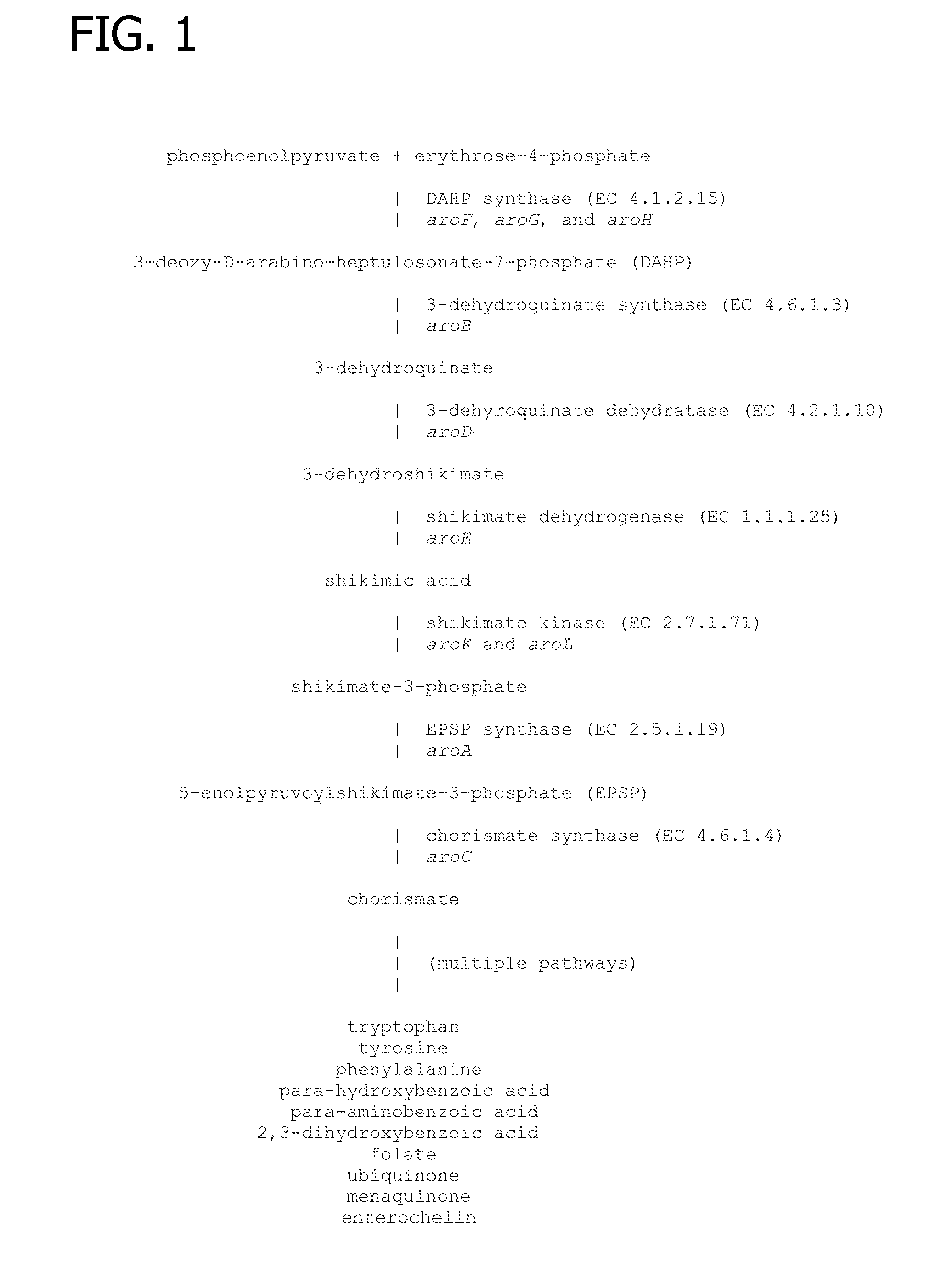Use of glyphosate to produce shikimic acid in microorganisms
- Summary
- Abstract
- Description
- Claims
- Application Information
AI Technical Summary
Benefits of technology
Problems solved by technology
Method used
Image
Examples
example 1
Construction of a pBR322—Derived Plasmid Expressing an Unregulated pheA Gene Encoding a Chorismate Mutase-Prephenate Dehydratase Enzyme that is Resistant to Feedback-Inhibition by Phenylalanine
[0050]A pheA gene with three alterations in the nucleotide sequence was prepared by DNA synthesis as an EcoRI-BamHI restriction fragment (SEQ ID NO: 1). The technique of DNA synthesis is known in the art (Khudyakov and Fields, 2003).
[0051]The three alterations were:[0052]1. A promoter-up mutation in the −10 region of the pheA promoter, changing it from TACTGTA to TATAATA (FIG. 2)[0053]2. A 146 bp deletion between the pheA promoter and the ribosome binding site (RBS) of the pheA gene, removing the pheA attenuator region including the pheL leader peptide gene (FIG. 2)[0054]3. A 6 bp deletion spanning codons 304-305-306 of the pheA gene, altering the amino acid sequence of the encoded chorismate mutase-prephenate dehydratase from Ala-303, Thr-304, Gly-305, Gln-306, Gln-307 to Ala-Lys-Gln (SEQ ID ...
example 2
Construction of a pSC101-Derived Plasmid Expressing an Unregulated pheA Gene Encoding a Chorismate Mutase-Prephenate Dehydratase Enzyme that is Resistant to Feedback-Inhibition by Phenylalanine
[0061]Plasmids derived from pBR322, such as pXT1457 described in Example 1, exist in an E. coli host cell at a copy number (the number of plasmid molecules per cell) of about 30; this copy number determination is described in Bogosian et al., International Publication No. WO 2007 / 035323 A1, which is hereby incorporated herein by reference in its entirety. To investigate the effect of the altered pheA gene when present on a lower copy number plasmid vector, a pSC101-derived cloning vector was constructed. The plasmid pSC101 has a copy number of about 15 (Hasunuma and Sekiguchi, 1977), which is intermediate between that of low copy number plasmids and high-copy number plasmids such as pBR322 (Armstrong et al., 1984).
[0062]The starting plasmid was the cloning vector pXT995. The plasmid pXT995 and...
example 3
Treatment of Strains with Glyphosate
[0065]The untransformed host strain LBB427 and the host strain LBB427 transformed with the plasmid pXT1457 were grown in 50 milliliters of the Vogel-Bonner minimal culture medium described in Example 1. For the strain LBB427 transformed with the plasmid pXT1457, ampicillin was included in the culture medium at 100 milligrams per liter. The cultures were grown in flasks, on an incubator shaker operating at 300 rpm and 37 degrees Celsius. At 2.5 hours after inoculation, N-(phosphonomethyl)glycine was added to a concentration of 3.38 grams per liter (20 millimolar). Growth of the cultures was almost completely inhibited by this level of glyphosate. At 24 hours after inoculation (i.e., 21.5 hours after N-(phosphonomethyl)glycine addition), the cells were pelleted by centrifugation, and the culture supernatants were analyzed for shikimic acid content using the HPLC assay described in Example 1. The culture supernatants of the host strain LBB427 transfo...
PUM
| Property | Measurement | Unit |
|---|---|---|
| Temperature | aaaaa | aaaaa |
| Strain point | aaaaa | aaaaa |
Abstract
Description
Claims
Application Information
 Login to View More
Login to View More - R&D
- Intellectual Property
- Life Sciences
- Materials
- Tech Scout
- Unparalleled Data Quality
- Higher Quality Content
- 60% Fewer Hallucinations
Browse by: Latest US Patents, China's latest patents, Technical Efficacy Thesaurus, Application Domain, Technology Topic, Popular Technical Reports.
© 2025 PatSnap. All rights reserved.Legal|Privacy policy|Modern Slavery Act Transparency Statement|Sitemap|About US| Contact US: help@patsnap.com


